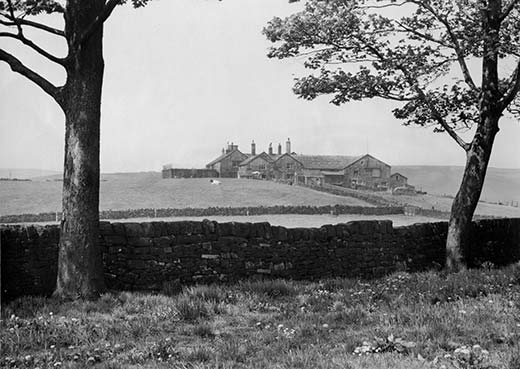Thursday, 20 November 2025
Hebden Bridge Local History Society Report
Echoes from the meadows:
a history of High Hirst Farm
Speaker: Paul Knights

Idyllic scenes of hay-making in the woodland meadow near where High Hirst Farm used to stand seemed to capture old times. Paul Knights, speaking to Hebden Bridge Local History Society, described how the grand 16th century building once dominated the skyline, looking over Hebden Bridge from the hilltop now occupied by the Dodnaze Estate, high above Birchcliffe. The meadow is now home for a community project and once a year local people gather in the harvest, using traditional methods – scything and raking the cut grass, forming small haycocks to speed up the drying and carrying the hay to an improvised baler.
They hold a traditional harvest picnic, celebrating the end of a cycle. Once the harvest is gathered, local people with livestock to feed collect the bales and sheep belonging to a local farmer are brought to graze the aftermath. Volunteers ensure that the sheep are cared for during their short stay, and the slow rhythm of the year continues. With support from Hebden Royd council, the community undertake surveys of the bio-diversity, studying fungi, moths and insects. They coppice hazel and grow fruit in the community orchard. The result is an area richer in species and helping with flood mitigation.
The echoes of the past are unmistakable and Paul has been drawn to discover as much as he can about the history of High Hirst Farm. The house, demolished in 1960, is thought to date back to 14th century, when it would have been a timber framed building, but like other grand houses in Calderdale, it was either re-built or encased in stone in the early 17th century. There is evidence from wills and other documents that an Abraham Nayler was the owner of the farm at the time of its rebuilding, dated to 1629.
But by the mid-19th century the house suffered the fate of many grand houses and was divided into five cottages. Censuses confirm that farming continued on the site through the centuries, with one of the cottages occupied by a farmer, while the others housed weavers and tradesmen. No longer an isolated farm, High Hirst grew in the 19th century into a small hamlet of working people.
Auction notices provide an insight into the kind of farming they practised, advertising herds of dairy cattle, a thriving milk round and poultry, alongside traditional agricultural tools. In the farming survey of 1943 the land was largely given to pasture and meadow with a small field growing oats. There was no mechanisation, and a working mare rather than a tractor.
The last person to farm the land was Thomas Greenbank, and in 1946 the farm was bought by Hebden Royd council, the land ear-marked for housing development. There is little sign of the house that once stood there, but celebrations of the harvest echo long gone gatherings at Whit, the cricket clubs and the flower shows.
Remarkably, in the audience was a stronger link - someone born on the farm in 1936, one of the Greenbank family, with his own strong memories of the place.
Hebden Bridge Local History Society meets from September until April on the second and fourth Wednesday of the month at Hebden Royd Methodist Church, starting at 7.30 pm. Details of the History Society talks programme, publications and of archive opening times are available on the "What's on" section of the HebWeb, on the History website and you can also follow the History Society Facebook page.
With thanks to Sheila Graham for this report
See previous reports in the HebWeb History section

